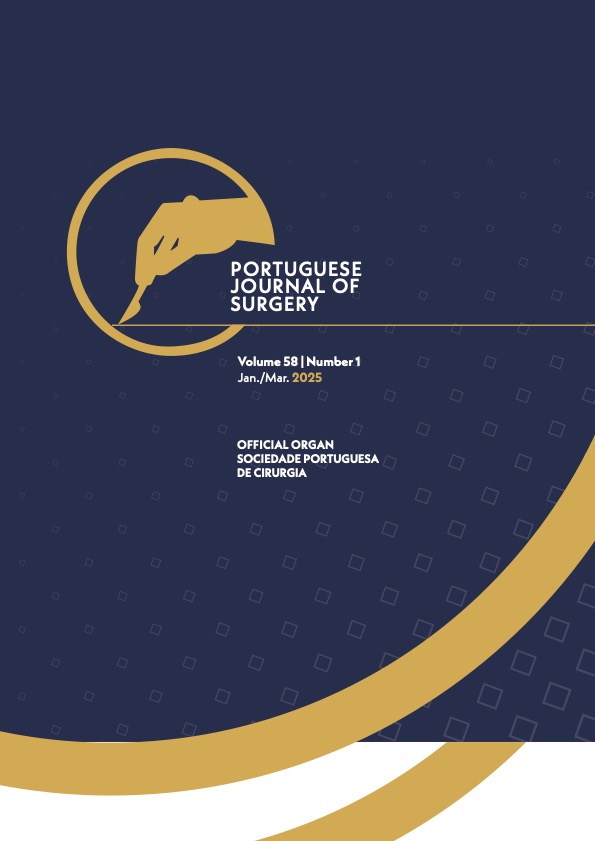Predictive Factors for Intensive Care Unit Admission After Cytoreductive Surgery with Hyperthermic Intraperitoneal Chemotherapy in Patients with Peritoneal Disease: A Single Center Retrospective Review
DOI:
https://doi.org/10.34635/rpc.1077Keywords:
Cytoreduction Surgical Procedures, Hyperthermic Intraperitoneal Chemotherapy, Peritoneal Neoplasms, Postoperative ComplicationsAbstract
Introduction: Cytoreductive surgery with hyperthermic intraperitoneal chemotherapy (CRS+HIPEC) is a locoregional surgical therapy applied in patients with peritoneal-only metastatic disease of primary abdominal malignancies and is associated with increased overall survival. Our goal was to evaluate short-term outcomes after CRS+HIPEC regarding surgical morbidity, as well as to identify factors associated with selective Intensive Care Unit (ICU) admission and to assess the safety of managing these patients outside of the ICU.Methods: A unicentric, retrospective, observational study of patients submitted to CRS+HIPEC between January 2016 and December 2020 at Instituto Português de Oncologia do Porto (IPO-Porto), was performed.
Results: During this period, 259 surgeries were performed. The majority of patients (68.7%) had no complications, 22.8% had CT-CAE 1/2 complications, 7.7% had CT-CAE 3/4 and 0.8% (n=2) died in the first 30 days postoperative (CT-CAE 5). Thirty-four percent (n=87) of patients were admitted to the ICU for postoperative surveillance (<48 hours). Patients who were not admitted to ICU demonstrated similar overall morbidity to the patients admitted to ICU for <48 hours. Predictive factors for ICU admission (p<0.05) were PCI>13, intraoperative blood loss>200 mL and cisplatin as the cytostatic agent.
Conclusion: Admittance to the ICU should not be standardized for every patient after CRS+HIPEC but rather stratified according to the complexity of surgical debulking.
Downloads
References
Wajekar AS, Solanki SL, Patil VP. Postoperative complications and critical care management after cytoreduction surgery and hyperthermic intraperitoneal chemotherapy: A systematic review of the literature. World J Crit Care Med. 2022;11:375-86. doi:10.5492/wjccm.v11.i6.375
Mehta SS, Gelli M, Agarwal D, Goéré D. Complications of cytoreductive surgery and HIPEC in the treatment of peritoneal metastases. Indian J Surg Oncol. 2016;7:225-9. doi:10.1007/s13193-016-0504-6
Foster JM, Sleightholm R, Patel A, Shostrom V, Hall B, Neilsen B, et al. Morbidity and mortality rates following cytoreductive surgery combined with hyperthermic intraperitoneal chemotherapy compared with other high-risk surgical oncology procedures. JAMA Netw Open. 2019;2:e186847 . doi:10.1001/jamanetworkopen.2018.6847
Hotza G, Karageorgos M, Pastourmatzi V, Banivovda N, Kyziridis D, Kakkonsa A, et al. Morbidity and mortality of patients with peritoneal malignancy following cytoreductive surgery and hyperthermic intraperitoneal chemotherapy. Discov Oncol. 2024;15:106. doi:10.1007/s12672-024-00968-4
Sugarbaker PH, Van der Speeten K. Surgical technology and pharmacology of hyperthermic perioperative chemotherapy. J Gastrointest Oncol. 2016;7:29-44. doi: 10.3978/j.issn.2078-6891.2015.105.
López-Basave HN, Morales-Vasquez F, Mendez-Herrera C, Namendys-Silva SA, Luna-Ortiz K, Calderillo-Ruiz G, et al. Intensive care unit admission after cytoreductive surgery and hyperthermic intraperitoneal chemotherapy. Is it necessary?. J Oncol. 2014;2014:307317. doi:10.1155/2014/307317
Mogal HD, Levine EA, Fino NF, Obiora C, Shen P, Stewart JH, et al. Routine Admission to Intensive Care Unit After Cytoreductive Surgery and Heated Intraperitoneal Chemotherapy: Not Always a Requirement. Ann Surg Oncol. 2016;23:1486-95. doi:10.1245/s10434-015-4963-8
Mendes J, Marques S, Peyroteo M, et al. Repeat cytoreduction with Hyperthermic Intraperitoneal chemotherapy in patients with peritoneal disease: A 5-year retrospective analysis. Surg Oncol. 2024;54:102078. doi:10.1016/j.suronc.2024.102078
Elgendy H, Iqbal M, Youssef T, Alzahrani A, Rugaan A. Optimizing risk factors influence Intensive Care stay after Hyperthermic Intraperitoneal Chemotherapy? An observational cohort study. Cancer Treat Res Commun. 2022;33:100653. doi:10.1016/ctarc.2022.100653
Kapoor S, Bassily-Marcus A, Alba Yunen R, Tabrizian P, Semoin S, Blankush, et al. Critical care management and intensive care unit outcomes following cytoreductive surgery with hyperthermic intraperitoneal chemotherapy. World J Crit Care Med. 2017;6:116-23. doi:10.5492/wjccm.v6.i2.116.
Hübner M, Kusanura S, Villeneuve L, Al-Naimi A, Alyami M, Balonov K, et al. Guidelines for Perioperative Care in Cytoreductive Surgery (CRS) with or without hyperthermic IntraPeritoneal chemotherapy (HIPEC): Enhanced recovery after surgery (ERAS®) Society Recommendations - Part I: Preoperative and intraoperative management. Eur J Surg Oncol. 2020;46:2292-310. doi:10.1016/j.ejso.2020.07.041
Harper MM, Kim J, Pandalai PK. Current Trends in Cytoreductive Surgery (CRS) and Hyperthermic Intraperitoneal Chemotherapy (HIPEC) for Peritoneal Disease from Appendiceal and Colorectal Malignancies. J Clin Med. 2022;11:2840. doi:10.3390/jcm11102840
Chouliaras K, Levine EA, Fino N, Shen P, Votanopoulos KI. Prognostic Factors and Significance of Gastrointestinal Leak After Cytoreductive Surgery (CRS) with Heated Intraperitoneal Chemotherapy (HIPEC). Ann Surg Oncol. 2017;24:890-7. doi: 10.1245/s10434-016-5738-6.
Freysnes IS, Larsen SG, Spassjevic M, Dueland S, Flatmark K. Complete cytoreductive surgery and hyperthermic intraperitoneal chemotherapy for colorectal peritoneal metastasis in Norway: Prognostic factors and oncology outcome in a national patient cohort. J Surg Oncol. 2016;114:222-7. doi:10.1002/jso.24290
Chicago Consensus Working Group. The Chicago Consensus on peritoneal surface malignancies: Standards. Cancer. 2020;126:2516-24. doi:10.1002/cncr.32825
Downloads
Published
Issue
Section
License
Copyright (c) 2022 Portuguese Journal of Surgery

This work is licensed under a Creative Commons Attribution-NonCommercial-NoDerivatives 4.0 International License.
Para permitir ao editor a disseminação do trabalho do(s) autor(es) na sua máxima extensão, o(s) autor(es) deverá(ão) assinar uma Declaração de Cedência dos Direitos de Propriedade (Copyright). O acordo de transferência, (Transfer Agreement), transfere a propriedade do artigo do(s) autor(es) para a Sociedade Portuguesa de Cirurgia.
Se o artigo contiver extractos (incluindo ilustrações) de, ou for baseado no todo ou em parte em outros trabalhos com copyright (incluindo, para evitar dúvidas, material de fontes online ou de intranet), o(s) autor(es) tem(êm) de obter, dos proprietários dos respectivos copyrights, autorização escrita para reprodução desses extractos do(s) artigo(s) em todos os territórios e edições e em todos os meios de expressão e línguas. Todas os formulários de autorização devem ser fornecidos aos editores quando da entrega do artigo.



